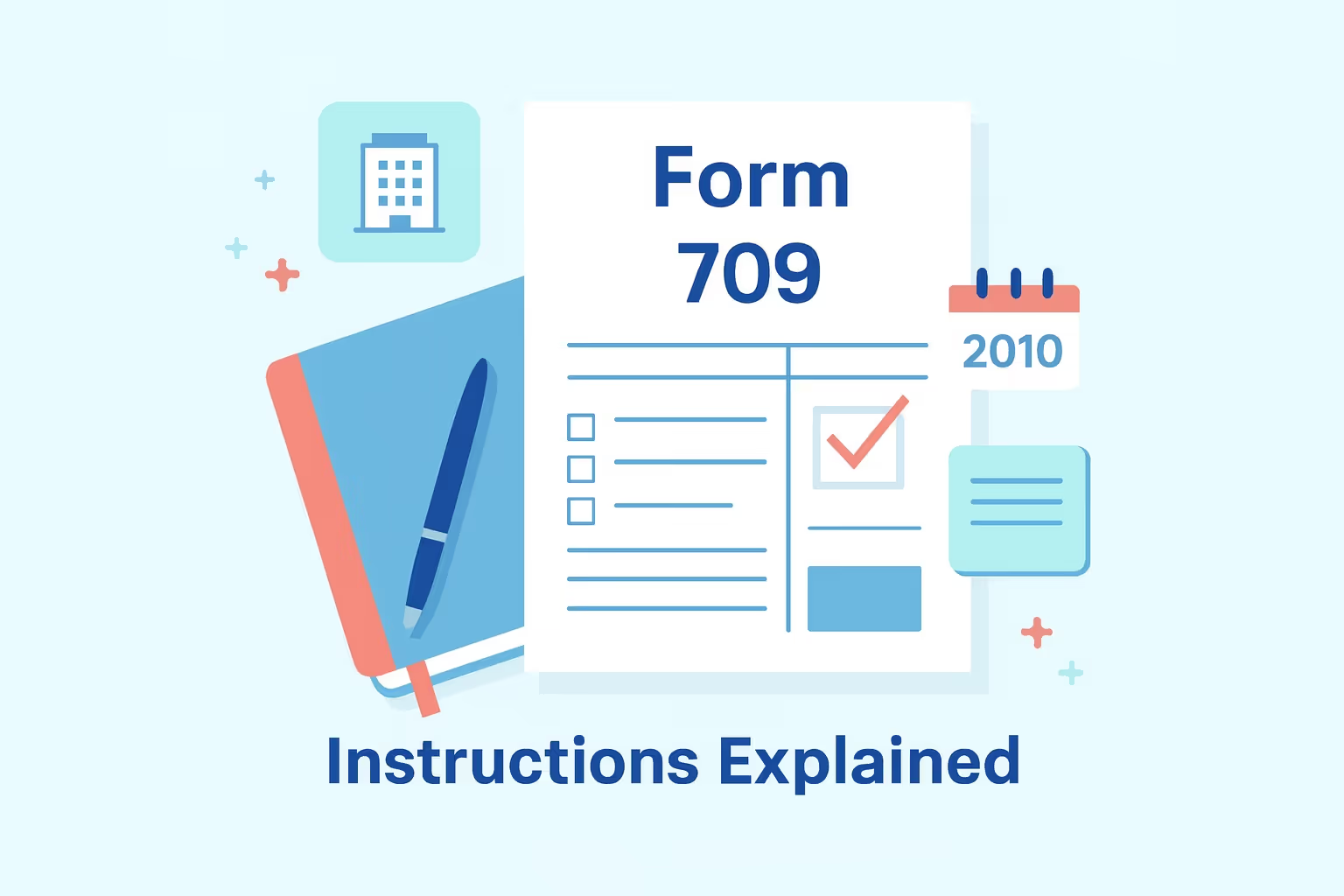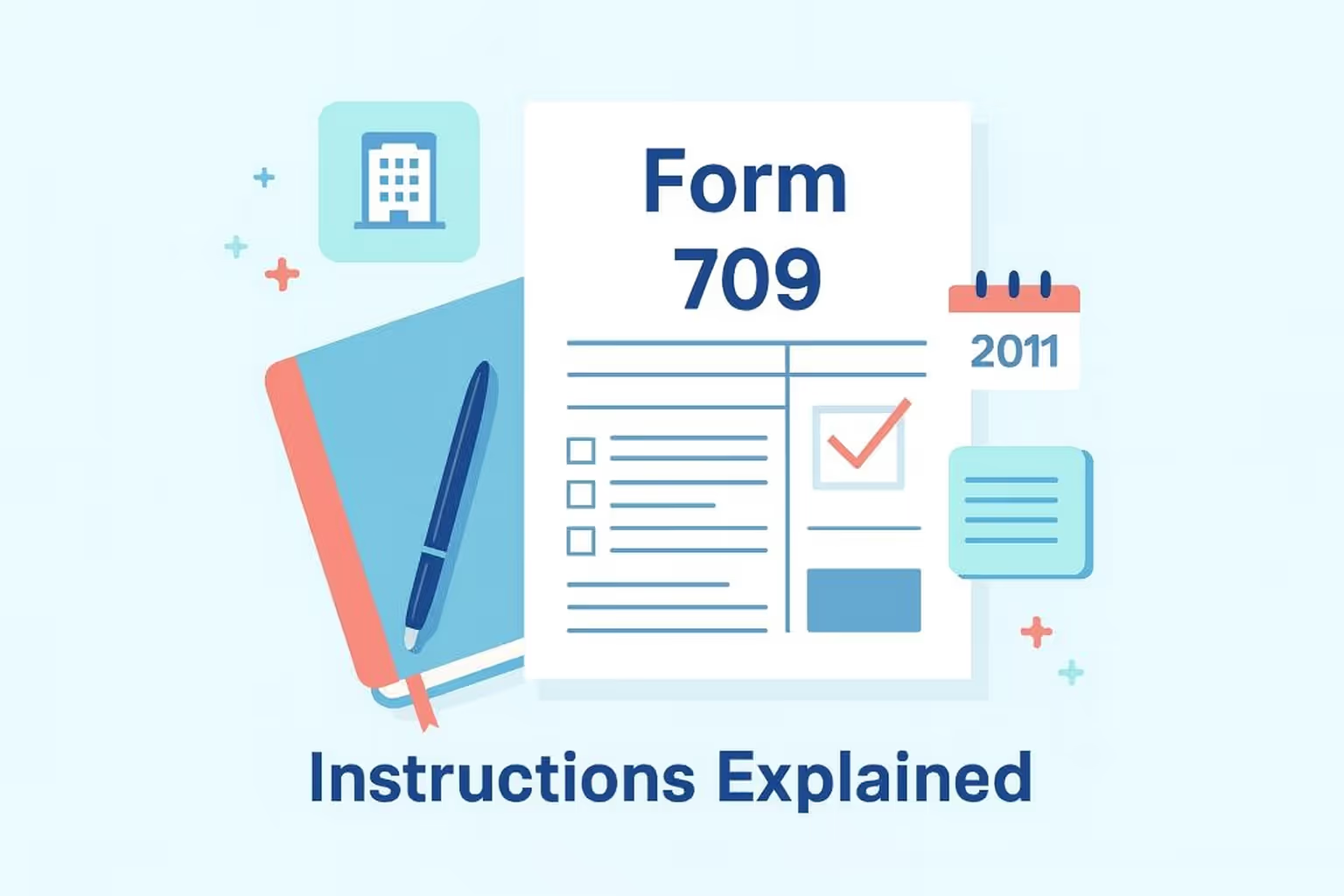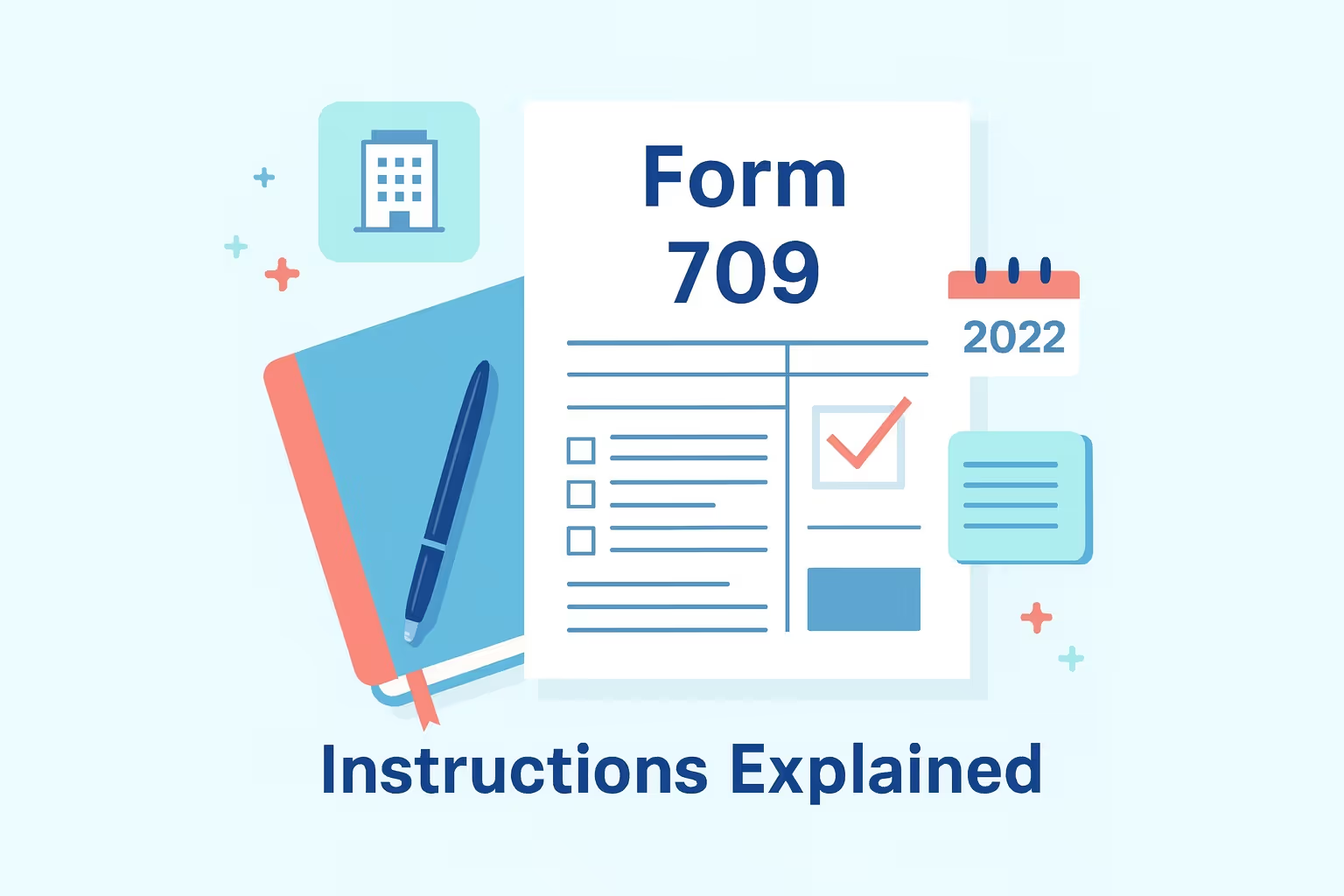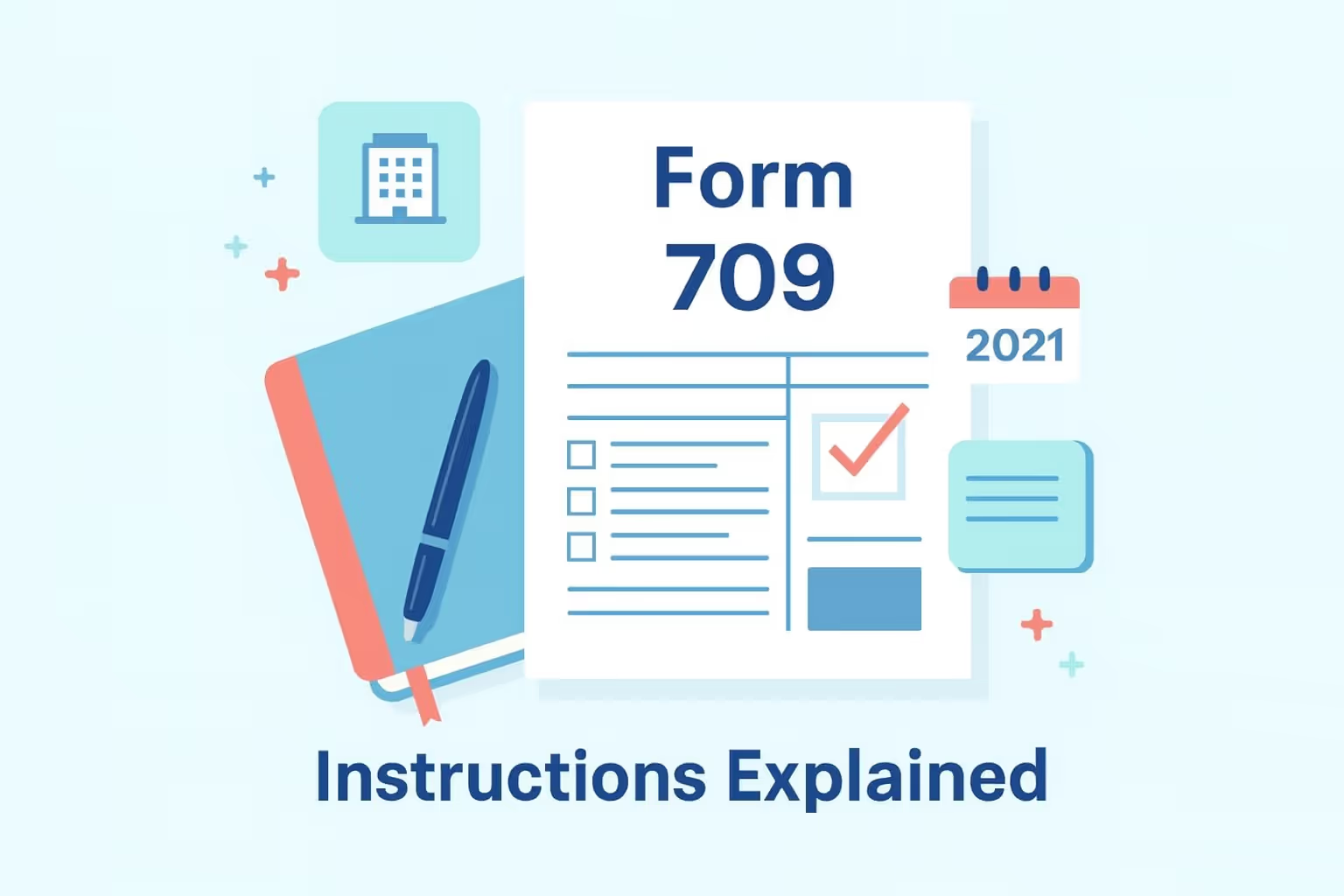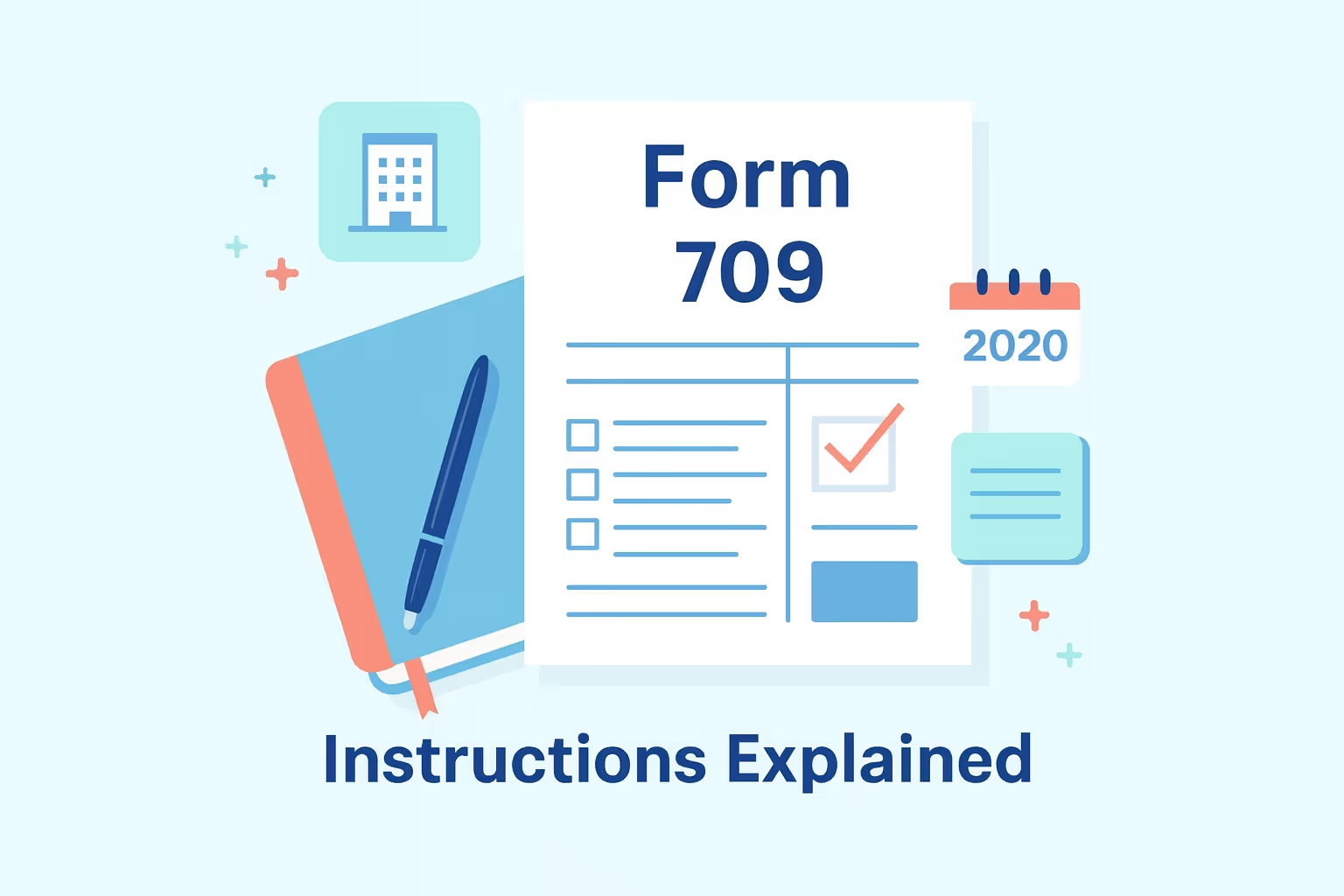Form 709 2019 Instructions: Filing Gift Tax Return

The Internal Revenue Service requires taxpayers to file a federal gift tax return when certain gifts exceed the annual exclusion or involve future interests. Form 709 documents these transfers, calculates potential liability, and tracks lifetime exemption usage. Several key amounts changed for the 2019 tax year, making it important to follow the proper reporting process.
Understanding how the annual gift tax exclusion works is essential to avoiding mistakes. While many gifts qualify tax-free, others must be reported even when no tax is ultimately owed. This guide covers the required steps, schedules, and calculations that ensure compliance when reporting taxable gifts for 2019.
The following sections explain filing triggers, required schedules, generation skipping transfer tax considerations, and how deceased spousal unused exclusion amounts may apply. With careful attention to fair market values, documentation, and deadlines, taxpayers can complete Form 709 accurately while maintaining future estate planning flexibility.
Overview of the Gift Tax Return
Form 709, officially known as the United States Gift (and Generation-Skipping Transfer) Tax Return, records gifts that exceed the annual exclusion and certain transfers requiring special treatment. It ensures accurate tax computation and establishes a permanent record of lifetime gifts for future estate tax purposes.
- Federal gift tax return: This is not combined with an individual income tax return but must be filed separately for every calendar year with reportable gifts.
- Taxable gifts include transfers above the annual exclusion amount, split gifts requiring the spouse’s consent, or property transferred with restricted use.
- Lifetime gift tax exemption: Each filer applies a portion of the applicable exclusion amount to reduce current liability while tracking cumulative transfers for estate tax planning.
- Generation-skipping transfer tax: Some transfers to grandchildren or unrelated younger individuals may trigger additional GST taxes in addition to the standard gift tax.
- IRS Form requirements: The form contains multiple schedules for prior gifts, taxable gift reconciliation, and unified credit use, ensuring accurate lifetime exemption accounting.
Annual Gift Tax Exclusion Rules
The annual gift tax exclusion sets the reporting threshold. In 2019, the exclusion amount was adjusted to $15,000 per recipient. Understanding how the exclusion applies helps prevent errors in filing taxes.
- Annual exclusion limit: Each taxpayer may give up to $15,000 in tax-free gifts per person in 2019 without using lifetime exemption amounts.
- Gift tax annual exclusion: Married couples may double the yearly limit through gift-splitting, but both must file their own form showing the spouse’s consent to split gifts.
- Annual exclusion amount: The exclusion applies on a per-recipient basis. Ten gifts of $15,000 each qualify fully without reducing the lifetime exemption.
- Annual limit application: The exclusion resets each tax year. A gift on December 31 and another on January 1 qualify for separate annual exclusion treatment.
- Future interests: Gifts where the recipient cannot immediately use or enjoy the property transferred never qualify for the annual exclusion and must be reported.
Gift Tax Purposes and Key Terms
For tax purposes, specific definitions control whether a transfer counts as a gift and whether it qualifies for the exclusion. These terms shape how taxpayers report gifts and calculate liability.
- Tax-free gifts: Transfers below the annual exclusion or deductible gift transfers to qualifying charities or specific exempt organizations do not use the exemption amounts.
- Lifetime exemption: This is the total applicable exclusion amount available during life, allowing individuals to offset gift tax calculated on taxable gifts reported.
- Unified credit: The credit tied to the lifetime gift tax exemption reduces tax liability on cumulative lifetime gifts and estate tax exemption at death.
- Future interests: Gifts subject to restrictions, such as trust funds, are unavailable until a future date and always require reporting, even when under the annual exclusion limit.
- Fair market value: All property transferred must be reported at its fair market value on the date of transfer, not at the historical purchase price or future valuation.
Generation Skipping Transfer Considerations
Some transfers are subject to both gift tax and generation-skipping transfer tax. For the 2019 tax year, the GST exemption matched the estate tax exemption, but strict rules apply.
- Generation skipping transfer: This applies when property is transferred, skipping a generation, such as gifts to grandchildren or transfers to unrelated individuals significantly younger.
- Gift and GST taxes: Both taxes may apply to the same transfer, requiring careful tracking of exemption amounts to prevent unintended liability.
- Lifetime GST exemption: Each filer had an $11.4 million GST exemption in 2019 that could be allocated to qualifying transfers to avoid GST taxes later.
- GST taxes allocation: Exemptions may be strategically assigned to trusts or gifts with growth potential, preserving long-term benefits for future generations.
- Tax purposes: Allocating GST exemption requires consistent recordkeeping across prior periods and present-year forms to ensure compliance with Internal Revenue Service standards.
Deceased Spousal Unused Exclusion
A surviving spouse may be able to apply the deceased spousal unused exclusion amount, also called DSUE, to their own gifts. This provision can extend overall exemption limits if properly documented.
- Deceased spousal unused exclusion: A surviving spouse can use a deceased spouse’s unused exclusion amount if an estate tax return elected portability.
- Surviving spouse benefits: DSUE preserves a larger applicable exclusion amount for lifetime gifts and eventual estate tax reporting.
- Unused exclusion amount: Only the most recent deceased spouse’s exclusion applies, and remarriage may limit the ability to use prior exclusions.
- Prior gifts consideration: DSUE must be tracked alongside prior periods of lifetime gifts to prevent exceeding available exemption amounts.
- IRS form reporting: DSUE entries are made on Schedule C, with full details of the deceased spouse, dates, and applicable exclusion applied for tax purposes.
Step-by-Step: Completing Form 709
Completing Form 709 requires careful attention to details on Page 1 and in each schedule. The following steps guide you through the federal gift tax return process for 2019.
Step 1: Enter Donor Information
Provide your legal name, Social Security number, domicile, and citizenship. Indicate whether you filed in prior periods, requested an automatic extension, or changed addresses.
Step 2: Elect gift-splitting
Married couples using split gifts must check the election box and include the spouse’s consent. Both must file their own form for the same calendar year.
Step 3: Apply Deceased Spousal Unused Exclusion
If any DSUE is available, enter the deceased spouse’s information and unused exclusion amount. Report this in Schedule C to adjust applicable exclusion amounts.
Step 4: Report Current Year Gifts
List all reportable gifts made during the tax year, describing each property transferred, date, recipient, relationship, adjusted basis, and fair market value on the transfer date.
Step 5: Complete Schedules and Reconciliation
Use Schedule A for taxable gifts, Schedule B for prior gifts, Schedule C for DSUE, and Schedule D for generation skipping transfer entries. Perform taxable gift reconciliation.
Required Schedules and Attachments
After completing the main section of Form 709, filers must address each schedule that supports the federal gift tax return. These schedules ensure accurate reporting of total taxable gifts and lifetime exemption use.
Schedule A: Reporting Taxable Gifts
Schedule A is where you list gifts subject to federal gift tax and complete taxable gift reconciliation. Every property transferred must be included with full details.
- Property transferred: Describe each item in detail, including real estate addresses, CUSIP numbers for securities, or other identifying features for accuracy.
- Fair market valuation: Report fair market value on the transfer date, supported by appraisals or reliable pricing sources, not historical purchase cost.
- Annual exclusion application: Subtract the annual exclusion amount for each qualifying gift, leaving only gifts that reduce the lifetime exemption or trigger tax liability.
- Deductible gift treatment: Record deductible gift transfers to charitable organizations or qualifying charities, applying estate tax exemption rules where appropriate.
- Split gifts entries: If gift-splitting is elected, report half the value in the donor’s return and include the spouse’s consent on both forms filed.
Schedule B: Prior Periods
This schedule reconciles prior gifts to ensure the Internal Revenue Service properly calculates cumulative lifetime gifts when computing gift tax.
- Prior gifts reporting: List all prior gifts disclosed in earlier tax years, ensuring values match the original tax return and previously applied credits.
- Unified credit use: Report the portion of unified credit consumed to calculate the correct applicable exclusion remaining for future lifetime gifts.
- Taxable gifts carry forward: Add taxable gifts from earlier filings, showing how they combine with current-year gifts, for an accurate total taxable gifts figure.
- IRS office details: Identify the office where the prior tax form was filed to help the Internal Revenue Service verify accuracy and track cumulative filings.
- Cumulative reporting: This record establishes lifetime exemption use, preventing under-reporting liability across calendar years and helping with estate tax planning.
Schedule C: Deceased Spousal Unused Exclusion
Schedule C documents any DSUE transferred from a deceased spouse. When computing the gift tax, this adjustment increases the filer’s applicable exclusion amount.
- Deceased spouse identification: Enter the deceased spouse’s name, date of death, and proof that portability was elected through an estate tax return filing.
- Unused exclusion amount: Record the exact unused exclusion amount received and ensure it is reconciled with prior periods of lifetime gifts already reported.
- Applicable exclusion adjustment: Add DSUE to your lifetime exemption, increasing the total allowable applicable exclusion amount available for current taxable gifts.
- Surviving spouse requirement: Only the last deceased spouse’s unused exclusion applies. Remarriage can remove eligibility to use previously inherited exemption amounts.
- Schedule integration: Ensure values align with Schedule B and current entries on Schedule A to avoid discrepancies in tax computation.
Schedule D: Generation Skipping Transfer
Schedule D covers generation skipping transfer reporting and allocation of GST exemption.
- Direct skips: Record gifts made directly to individuals more than one generation below the donor, which may trigger GST taxes and require exemption allocation.
- Indirect skips: Include transfers to trusts where future distributions may eventually skip a generation, ensuring consistent reporting for tax purposes.
- Lifetime GST exemption: Apply part of the lifetime GST exemption to reduce GST taxes, aligning with estate tax exemption values for the 2019 tax year.
- Tax computation: Enter the GST inclusion ratio and compute GST liability, if any, based on the taxable amount and current exemption allocations.
- Protective filings: Even where GST liability is uncertain, reporting establishes records that protect valuations and allocations under Internal Revenue Service review.
Filing Methods and Deadlines
The Internal Revenue Service allows Form 709 to be filed by paper or, in some cases, electronically. Choosing the right method depends on access to tax software and timing.
Electronic Filing
Electronic filing provides validation and faster confirmation, but not all tax professionals or software providers supported e-filing of Form 709 in 2019.
- E-file benefits: Electronic filing provides quicker acknowledgment, reduces clerical errors, and allows convenient electronic payment of any tax liability.
- Tax professional support: E-file may require working with a tax professional approved for IRS e-filing, especially for married couples with gift-splitting.
- Spouse’s consent: Both spouses must e-sign or provide approval through supported methods for split gifts. Without both, the split gifts election is invalid.
- Validation tools: IRS e-file systems check for missing entries and ensure accurate taxable gift reconciliation, lowering the chance of audit adjustments.
- Recordkeeping: E-filed returns still require taxpayers to maintain copies of appraisals, schedules, and documentation for Internal Revenue Service purposes.
Paper Filing
Paper filing remains the standard method for many federal gift tax return filers.
- Mailing addresses: Use IRS addresses specific to Form 709. Kansas City was the designated location for returns in the 2019 tax year.
- Assembly rules: Do not staple attachments. Instead, organize all schedules, appraisals, and documents to prevent delays in IRS processing.
- Certified mailing: Use accredited mail or an IRS-designated private delivery service to document timely filing, especially when taxable gifts are significant in value.
- Processing times: Paper filings typically take several weeks to process, delaying confirmation but remaining necessary where e-filing is unavailable.
- Own form requirement: Every taxpayer required to report gifts must submit their own form, even when married couples elect to split gifts.
Filing Deadlines
The deadline for Form 709 aligns with the deadline for individual income tax returns, but it only applies to reporting 2019 gifts.
- Standard due date: Returns for the 2019 tax year were due April 15, 2020, consistent with other federal filing tax obligations.
- Automatic extension: An extension on the individual income tax return also applies to Form 709, giving filers additional time for submission.
- Form 8892 option: This form requests an extension for filing a gift tax return when an income tax extension is not available.
- Payment deadlines: Extensions only extend the filing deadline. Any tax liability due must be paid by April 15 to avoid penalties or interest.
- Calendar-year basis: Form 709 always covers gifts made in one calendar year, and there is no option to combine multiple years on a single tax form.
Paying Gift Tax
Most filers do not pay gift tax for 2019 because the lifetime gift tax exemption offsets gifts. Still, liability can arise if cumulative gifts exceed the exclusion.
When Payment Is Due
Tax liability arises when lifetime gifts exceed the exemption. Taxpayers must track both current and prior gifts for accurate tax computation.
- Lifetime gifts: Add all prior gifts to the current year's taxable gifts to determine if the applicable exclusion amount has been surpassed.
- Tax liability trigger: If the cumulative total gifts exceed the lifetime exemption, the IRS requires payment of gift tax calculated under statutory rates.
- Unified credit offset: Gift tax calculated on taxable gifts is reduced by any available unified credit before determining final liability due.
- Estate tax connection: Lifetime gifts reduce estate tax exemption, meaning high-value transfers today can increase estate tax exposure in the future.
- Tax computation formula: Computing gift tax involves determining total taxable gifts, subtracting exemptions, and applying the Internal Revenue Service tax table.
Payment Methods
The IRS provides several methods for payment, each with its own rules and recommendations.
- Electronic Federal Tax Payment System: EFTPS allows direct transfers and provides security, scheduling, and proof of payment to cover transfer tax liabilities.
- Direct debit: Taxpayers filing electronically may authorize direct debit from their bank account, ensuring timely payment if any balance is owed.
- Credit card payments: Card payments are allowed, but fees apply. This option may be used if other electronic payment systems are unavailable.
- Check or money order: Paper returns can include checks payable to the United States Treasury, with identifying information noted for proper tax purposes.
- Partial payments: If any tax liability cannot be paid in full, taxpayers may submit a partial payment to reduce interest before seeking installment arrangements.
Valuation Rules for Property Transferred
Correct valuation of property transferred is central to computing the gift tax. The Internal Revenue Service requires consistent fair market assessments for tax purposes.
- Fair market requirement: Gifts must be reported at fair market value on the transfer date to ensure accurate tax liability and the correct annual exclusion application.
- Qualified appraisals: Appraisals are required for real estate, closely held business interests, or unique assets, as well as supporting values for gift and estate tax exemption purposes.
- Discounts allowed: Certain gifts of minority business interests may qualify for valuation discounts, but documentation must support the lack of control or marketability.
- Future interests impact: Future interests require special valuation rules, as restrictions or timing elements affect how the gift tax calculated totals are determined.
- Recordkeeping: Keep appraisals, contracts, and supporting documents for Internal Revenue Service audits to establish compliance with federal gift and GST taxes.
Advanced Strategies for Annual Gift Tax Exclusion
Maximizing the annual gift tax exclusion requires planning. Taxpayers can structure gifts to stay within annual limits while preserving the lifetime exemption for future transfers.
- Annual exclusion limit: Each donor may transfer $15,000 per donee per year without reducing the lifetime exemption, allowing substantial transfers when multiplied by recipients.
- Split gifts strategy: Married couples may give $30,000 per donee annually through gift-splitting, but both must file separate returns with the spouse’s consent.
- Calendar year planning: Timing gifts in December and January allows two separate annual exclusions within weeks, doubling tax gifts to the same recipient.
- Charitable gift planning: Deductible gift transfers to charitable organizations or qualifying charities may also reduce liability while achieving philanthropic goals.
- Estate tax link: Annual exclusion gifts reduce overall taxable estate values, lowering future estate tax liability while transferring assets during life.
Computing Gift Tax and Total Taxable Gifts
Once gifts are reported, the donor must compute tax using the total taxable gifts and apply available credits. Accuracy is essential to avoid penalties.
- Total taxable gifts: Add all reportable transfers for the year, subtract annual exclusion amounts, and apply deductions to calculate the year’s net taxable figure.
- Tax computation method: Apply statutory rates to cumulative lifetime gifts, then subtract the unified credit and applicable exclusion amount to calculate gift tax.
- Reconciliation required: Taxable gift reconciliation ensures that gifts from the current year and prior periods are combined properly for accurate Internal Revenue Service reporting.
- If any liability exists: Payment is due by the filing deadline. Interest and penalties accrue if any balance remains unpaid after April 15.
- Tax purposes: Accurate tax computation protects lifetime exemption totals and prevents issues during estate tax planning or later audits.
Common Errors to Avoid
Several mistakes frequently occur on Form 709. Awareness reduces the chance of IRS inquiries or penalties.
- Reporting only present-interest gifts: Many taxpayers mistakenly omit future interests, but only gifts that qualify as present interests escape mandatory filing.
- Incorrect exclusions: Applying the annual exclusion to non-qualifying gifts creates errors. Only present-interest gifts qualify for the annual exclusion amount.
- Missing spouse’s consent: gift-splitting without a spouse’s signature invalidates the election, leaving split gifts incorrectly reported for tax purposes.
- Improper valuations: Using the purchase price instead of the fair market value fails the Internal Revenue Service standards and risks adjustment.
- Documentation gaps: Missing trust instruments, appraisals, or supporting documents undermine compliance and invite IRS scrutiny.
Compliance and Recordkeeping
Maintaining accurate records ensures proper tracking of lifetime gifts, exemptions, and credits. Thorough files protect against disputes and aid estate planning.
- Tax form copies: Keep all prior gift tax returns, including schedules and attachments, for consistent cumulative reporting of lifetime gifts and unified credit use.
- Supporting documents: Maintain trust agreements, appraisals, contracts, and proof of charitable organization qualifications for deductible gift claims.
- Gift logs: A running log of total gifts by calendar year helps compute gift tax, track lifetime exemption, and plan estate tax.
- Professional review: Annual reviews with a tax professional ensure exemptions, valuations, and reporting align with Internal Revenue Service guidance.
- Future protection: Proper records establish evidence for future estate tax exemption claims and protect against adjustments in audits or estate administration.
Frequently Asked Questions
Do I need to file Form 709 if I gave more than $15,000 to one person in 2019?
Any gift exceeding the $15,000 annual exclusion requires filing Form 709—the excess counts toward your lifetime gift tax exemption, reducing your available applicable exclusion amount. While most taxpayers will not owe gift tax due to the unified credit, reporting ensures compliance and maintains accurate Internal Revenue Service records for estate tax planning.
Can married couples split gifts for 2019, and do both need to file Form 709?
Yes, gift-splitting allows married couples to double the annual exclusion limit, permitting $30,000 in tax-free gifts per recipient for 2019. However, both spouses must file Form 709 and indicate their spouse’s consent. The Internal Revenue Service requires matching returns, ensuring proper reporting of split gifts and preserving accurate lifetime gift and estate tax exemption records.
Are gifts to a trust for a grandchild considered future interests that require filing?
Yes, any gift made to a trust where the recipient cannot immediately use or enjoy the property is considered a future interest. Future interests never qualify for the annual exclusion, regardless of amount. They must be reported on Form 709, ensuring accurate taxable gift reconciliation and compliance with Internal Revenue Service rules regarding lifetime exemption and GST allocations.
How do I value stock or a closely held business interest for Form 709?
The Internal Revenue Service requires fair market value at the date of transfer for stock or closely held business interests. Market prices can determine the value of publicly traded stock, but a qualified appraisal is typically required for privately held businesses. Proper valuations ensure accurate tax computation, maintain compliance, and protect against challenges when computing gift tax and total taxable gifts.
What is the deceased spousal unused exclusion, and how do I use it?
The deceased spousal unused exclusion allows a surviving spouse to apply a deceased spouse’s unused exclusion amount to their own lifetime gifts. To use it, report the DSUE on Schedule C of Form 709, including the deceased spouse’s details. This increases your applicable exclusion amount, reduces future tax liability, and supports estate tax planning when computing gift and GST taxes.
What should I do now if I missed filing Form 709 for a prior year?
You should file the overdue Form 709 immediately. The Internal Revenue Service may impose penalties, but filing late establishes accurate prior gifts and exemption use records. Reporting late ensures taxable gifts from earlier periods are documented, allowing proper lifetime exemption tracking. Reporting protects compliance, avoids further penalties, and reduces risk during estate tax administration or future audits.



























